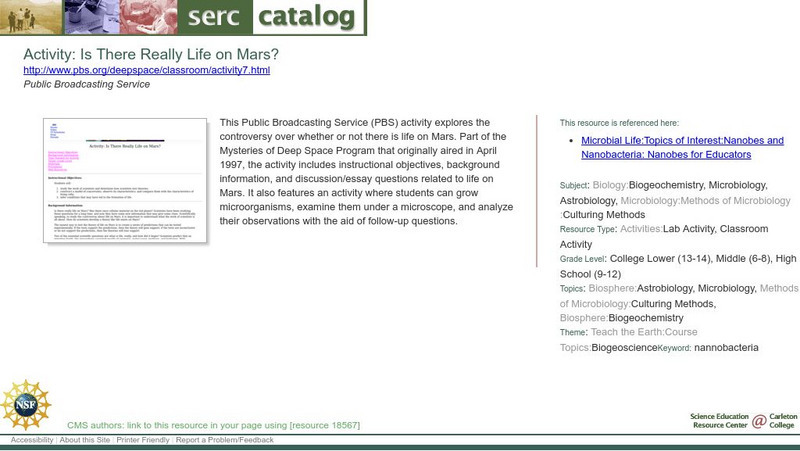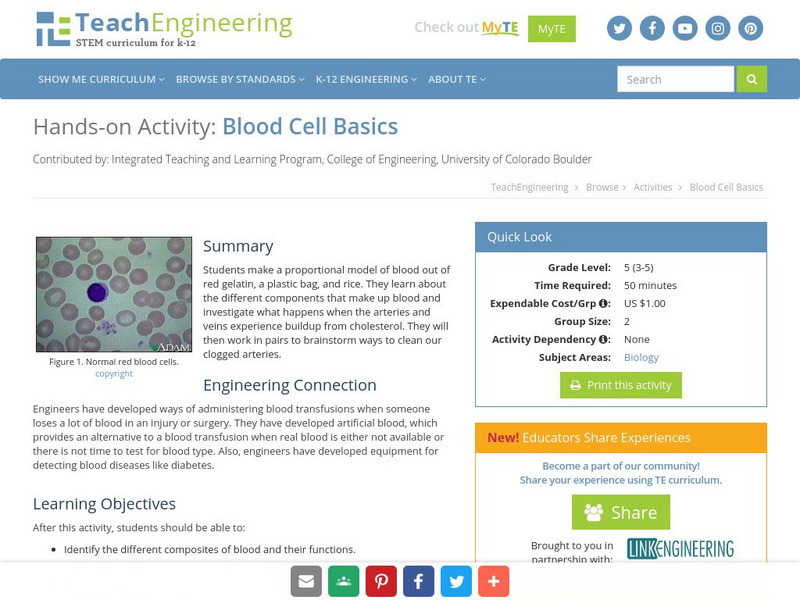Hi, what do you want to do?
Curated OER
How Animals Meet Their Needs
Fourth graders research the Internet for facts relating to the animal of their choice. They use information from their Internet search to complete their animal project. TLW use his or her own words when writing their report.
Curated OER
Fertilizer Frenzy
Ninth graders design and conduct an experiment. They evaluate other's experiments. Students describe relationships between biological systems and the environmental contaminants. They work as a team to solve a problem.
Curated OER
Crime Scene Investigation (CSI) with Powdery Mildew Fungi
Students explore a specific method of identifying fungi, using a written key and an illustrated key. Powdery mildew fungi can be identified to genus by the morphology (appearance) of the sexual stage (cleistothecia).
Curated OER
Food Webs in a Pond
Students explore food chains and food webs in a pond and identify common creatures found in ponds. They look for tadpoles, fish, mites and other creatures in a pond during a field trip for first hand research.
Curated OER
Cell Community
Seventh graders use technology to review cell structure and function. In this cells less, 7th graders review the parts and functions of a cell, and use photography/video and PowerPoint to enhance their explorations.
Curated OER
There Are Algae in Your House!
Learners demonstrate that, although we sometimes can neither smell nor taste them, many ingredients in our foods and household products come from the sea. They also investigate food eat to determine algae derivatives they contain.
Curated OER
One Square Foot
Students identify, describe, count, tally, and graph life found in one square foot of land.
Curated OER
Magnificent Magnification!
Students magnify their digital artwork to develop their motor skills with a mouse. Using the artwork, they discover how to look at it from different perspectives. They answer discussion questions as they complete the activity.
Curated OER
Water Purification
Young scholars develop an understanding and appreciation of water purification techniques and their implications for health maintenance.
Curated OER
Dilation
Tenth graders identidy and define various geometry terms, Students create exact replicas of a shape that is either smaller or larger than the original shape. Students prove that their entire shapes are larger or smaller in the same...
Curated OER
My Favorite Meal
Students investigate ecological systems and the multiple uses of the environment by studying the osprey population.
Other
Science Spot: Microscope Mania [Pdf]
This is a lab station lesson plan on microscopes (7th grade). There are several supplemental documents available to accompany this lab at: http://sciencespot.net/Pages/classbio.html - Click on Microscope Mania.
NASA
Microbes @ Nasa: Science Lesson Plan: Day One Microscope Activity [Pdf]
A middle school experiment on the cell structure of cyanobacteria.
Huntington Library
Huntington Library: Garden Lesson Plans: Investigation: Pollen Collection [Pdf]
After learning about what pollen is, its health effects, as well as how it benefits humans, students take part in a lab activity. For this, they collect schoolyard pollen on slides, stain it, and then examine it under a microscope.
Science Education Resource Center at Carleton College
Serc: Activity: Is There Really Life on Mars?
This Public Broadcasting Service (PBS) activity explores the controversy over whether or not there is life on Mars. Part of the Mysteries of Deep Space Program that originally aired in April 1997, the activity includes instructional...
TeachEngineering
Teach Engineering: Blood Cell Basics
In this lesson students learn about the circulatory system and how it relates to engineering. Then in a hands-on activity they create a model of blood. Students also act out cholesterol in a blocked artery and look at blood cell in a...
















![Science Spot: Microscope Mania [Pdf] Lesson Plan Science Spot: Microscope Mania [Pdf] Lesson Plan](https://static.lp.lexp.cloud/images/attachment_defaults/resource/large/FPO-knovation.png)

